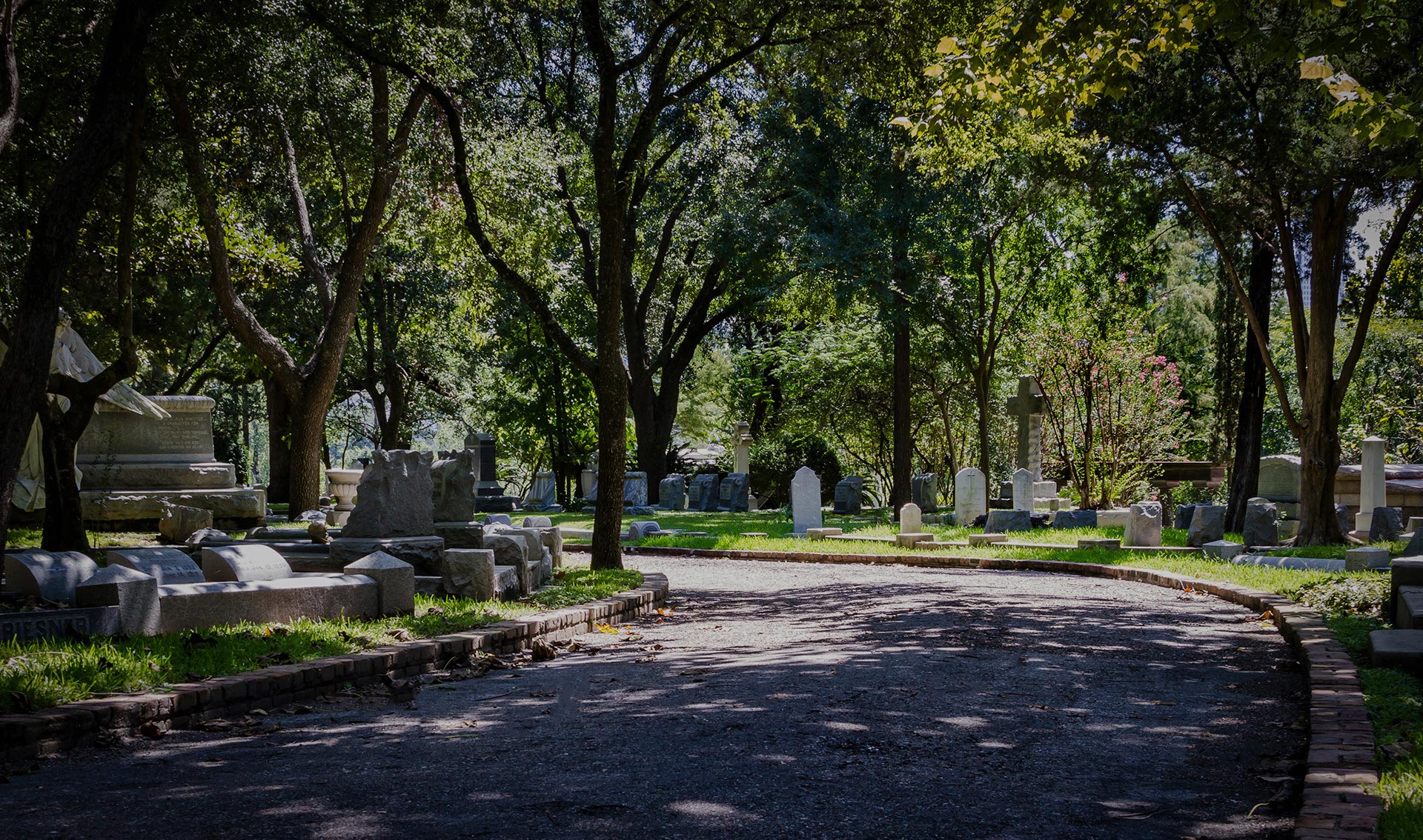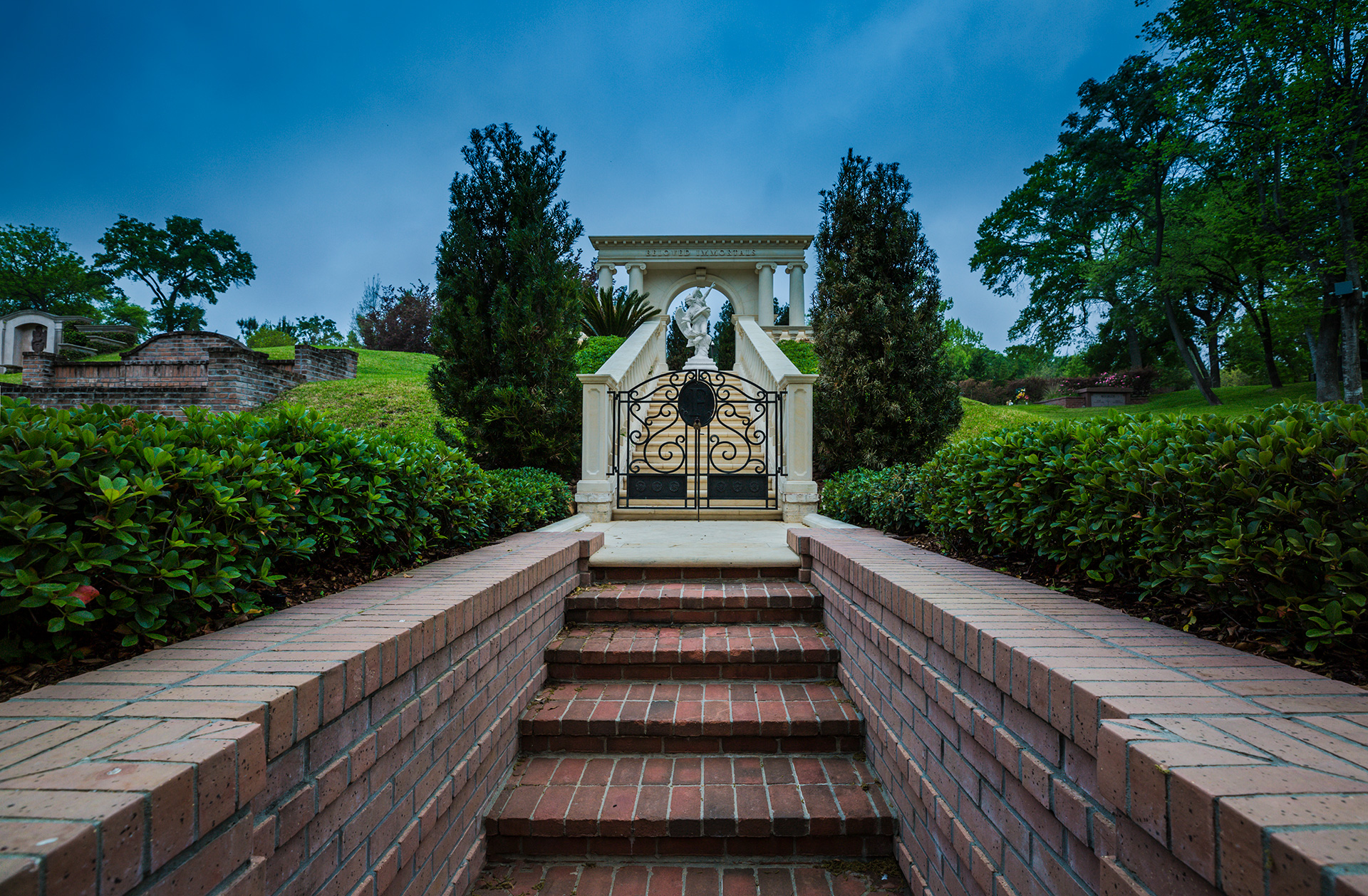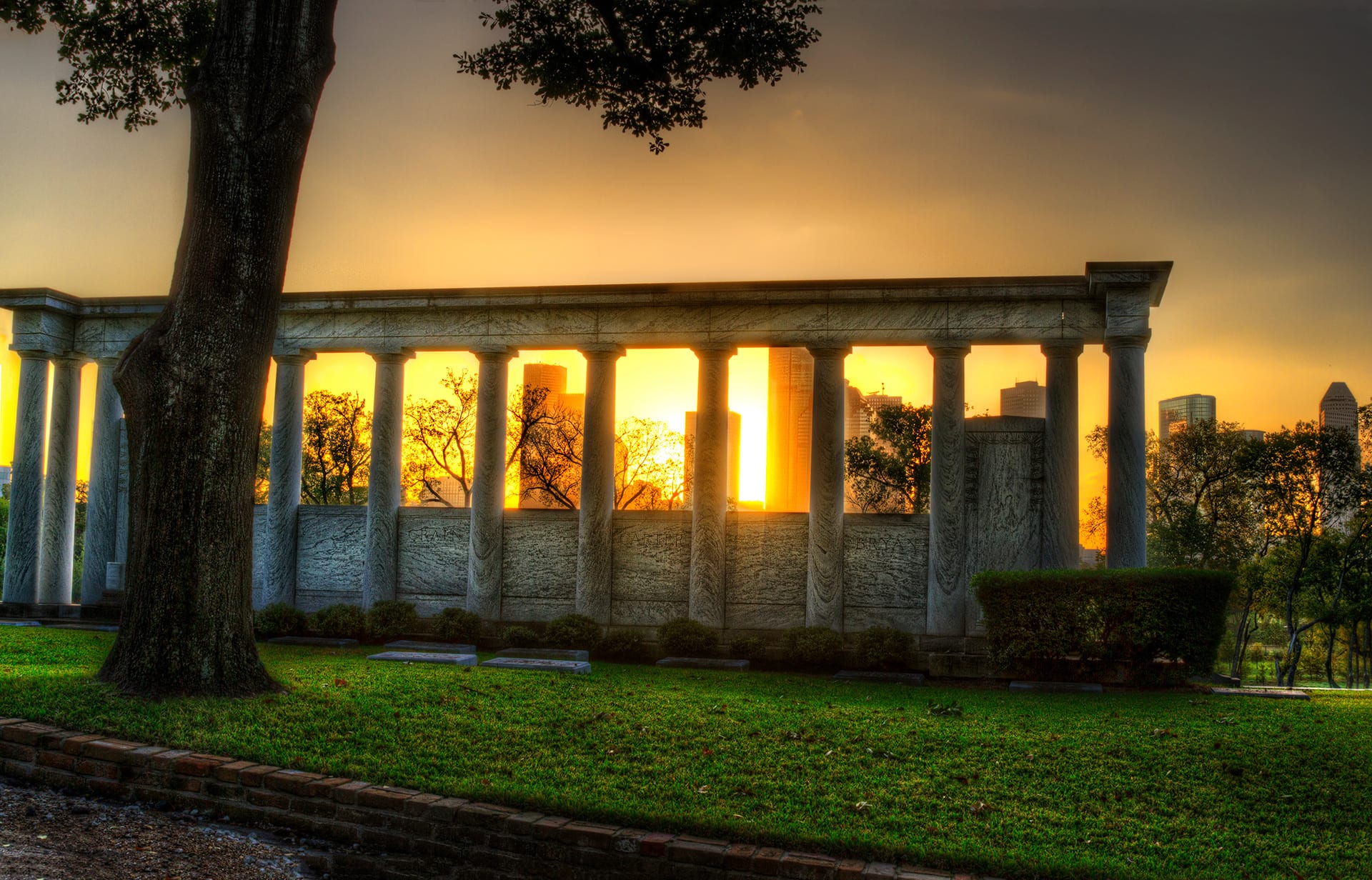
19th Century
Glenwood Cemetery was established as a private cemetery in 1871
Glenwood Cemetery was established as a private cemetery in 1871 by the Houston Cemetery Company, which was incorporated by an act of the Twelfth Legislature of the State of Texas on May 12, 1871. After construction, Glenwood opened for business in the summer of 1872.
Glenwood shares characteristics of other 19th century romantic garden cemeteries: it was established in a rural area (as Houston existed in 1871). It was built on a site with a distinguishing natural feature. Glenwood’s design takes advantage of the ravines leading to Buffalo Bayou to create a rolling landscape unique in Houston. It was landscaped in a naturalistic style with curving roads and walkways. Newspaper accounts of 1871 compared Glenwood to such well-known garden cemetery parks as Mount Auburn in Cambridge, Mass. (1831), Laurel Hill in Philadelphia (1836) and Green-Wood in Brooklyn (1838). Architectural historian Stephen Fox has written that Houstonians of the late 19th century considered Glenwood to be not only a cemetery but also a landscaped park. Improvements in streetcar transportation brought increasing numbers of visitors to Glenwood on pleasant Sunday afternoons.
For most of the first decade of Glenwood’s existence, its fortunes were guided by President W.B. Botts and the Board of Directors. Although minutes of the activities from those years have not been found, it is known that new sections were developed, and construction of infrastructure and improvements continued.
In 1886, J.C. Hutcheson was elected President. Under Hutcheson’s leadership, a new Code of Bylaws, Rules and Regulations was adopted, a Permanent Trust Fund was established, and what is believed to be the first engineered map of the cemetery was drawn and eventually recorded in the Harris County Clerk’s office.
In 1888, the office cottage was built, and an irrigation system and fountains were installed. The three-tiered fountain near the main entrance is believed to have been installed at that time. These improvements were followed by a conservatory/greenhouse in the area of the present Section East Avenue (today’s greenhouses are located in the shop area), and construction of the house fronting on Washington Avenue as a residence for the Superintendent.
A significant change in Glenwood’s management occurred in 1893 when Thomas Tinsley, a New York lawyer with various business interests, obtained majority control of the Houston Cemetery Company stock, and Tinsley’s associates replaced the former members of the Board of Directors. Through a series of disproportionate dividends, stock splits, loans and other fiscally questionable transactions, Tinsley enriched himself while neglecting the maintenance of the cemetery, which fell into a deplorable condition.
Public sentiment against Tinsley grew until, in March 1896, a group of disgruntled lot owners filed suit asking the court to appoint a Receiver for the Glenwood assets. William Christian was appointed Receiver the following month and, under the court’s supervision, he operated the cemetery and began to repair and rebuild the damage of the Tinsley years.
One of the Receiver’s priorities was the entrance bridge crossing the glen just inside the Washington Avenue gates. The original 1872 bridge had been made of wood, and Tinsley’s neglect had left it unusable. Funerals were forced to enter through the Kane Street gates. After several options were considered, it was decided in 1896 to fill the ravine under the bridge, installing a culvert to allow the water to flow west to east. The bridge surface and rails were described as “new masonry and concrete.” It is believed the present concrete rails were installed about 1920.
The formal brick and masonry gate posts and the ornamental iron fencing and gates, which mark the Washington Avenue entrance today, were constructed around 1900, giving Glenwood a prominent presence in the streetscape.

20th Century
Glenwood began to emerge from receivership in 1901
Glenwood began to emerge from receivership in 1901 when a group of prominent Houstonians led by Capt. James A. Baker, T.W. House Jr. and J.C. Hutcheson pledged their own funds to acquire the Glenwood assets and pay off the debt. By 1903, they had transferred the assets to the newly formed Glenwood Cemetery Association, which successfully managed the affairs of the cemetery until Glenwood Cemetery, Inc., a non-profit cemetery corporation, was formed in 1969.
The property that became Glenwood included a lake, probably an ox-bow of Buffalo Bayou. As development of the cemetery moved south toward what is now the Lakeview Section, improvements were made to the lake. It existed as a decorative amenity from 1915 until 1921, when it was filled except for the remnant that exists today in the northern part of the Lakeview Section and serves as part of a drainage system from the Oakdale Section out to Buffalo Bayou.
Flooding of that portion of the cemetery in 1920 may have influenced the decision to fill the lake. Significant repairs and drainage work were undertaken at that time, including construction of concrete retaining walls reinforcing the levee around the Forest Mound Section.
In 1925 the roads in the cemetery, which had been shell gravel, were paved to cut down on dust.
In the mid-20th century, events south of the cemetery impacted Glenwood. Buffalo Bayou was rechanneled several times, moving south away from Glenwood. More significantly, in the 1950s the construction of Memorial Drive claimed 7.6 acres of Glenwood land.
The Architectural Control Committee was created in 1974 to ensure that lot improvements conform to Glenwood standards. Improvements and enhancements continued, including significant work on the office cottage, installation of a fireproof vault for the cemetery records in 1985, and restoration of the fountain and pond near the entrance.
Another beautiful feature of Glenwood was constructed and dedicated in 1995. Glenwood’s graceful belvedere was a gift of Mr. and Mrs. Robert F. Strange through the Heitman Foundation. It serves as the centerpiece of several sections that came together from land reclaimed from a gully and developed for burial spaces in 1990.
At about the same time, the office cottage was expanded to include a conference room and additional office space and brought into compliance with the Americans with Disabilities Act. Construction of the guard house near the entrance bridge followed.
In 1999, through a merger with the Concerned Citizens for Washington Cemetery Care Inc., Glenwood assumed permanent responsibility for the restoration, operation and maintenance of adjacent Washington Cemetery. Washington Cemetery was established in the spring of 1887 by Deutsche Gesellschaft von Houston (German Society of Houston), and was generally known as the German Society Cemetery. The name was changed to Washington Cemetery during the summer of 1918. The first of three roads connecting Glenwood Cemetery with Washington Cemetery was built in 2000.

21st Century
Significant developments for Glenwood
The year 2005 marked a significant development for Glenwood. The SWA Group was commissioned to prepare a Master Plan to guide Glenwood’s future. The Master Plan will optimize development of remaining land resources while preserving the historic character of the cemetery and enhancing the historic landscape.
A book on the history of Glenwood Cemetery was published in April 2010 by Texas A&M University Press. Proceeds of book sales will benefit the Glenwood Cemetery Historic Preservation Foundation. Glenwood looks forward to a bright future while respecting and preserving its past.